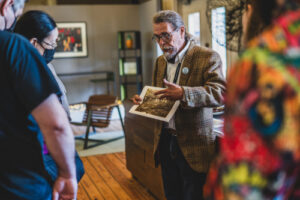Team: GWWO, Inc./Architects | RTA Architects | GE Johnson
Clients: Pikes Peak – America’s Mountain | City of Colorado Springs | United States Forest Service | Colorado Springs Utilities | US Army Research of Environmental Medicine | Broadmoor Pikes Peak Cog Railway
[metaslider id=6157]
[su_spoiler title=”Project Facts” style=”fancy”]
Location: Colorado Springs, CO
Project Type: Cultural
Area: 27,000 sf
[/su_spoiler]
Finding the perfect balance between a dynamic building that presents a clear destination to visitors and a minimalist structure deferential to the Peak and its majestic views was critical to the design of the new Pikes Peak Summit House.
Predominately a one-story form seemingly carved from the southeast side of the Peak, the new Summit House offers unobstructed views to the east. Reminiscent of the crags and rock formations found above the tree line, the design uses shade, shadows and fragmentation to coalesce into the Peak. Clad in material similar to Pikes Peak granite, the modern hue seamlessly blends into the mountainside. Viewed from below, it is one with the mountain, yet as one arrives at the Peak, the modest entry pavilion is a clear destination.
Upon approach, visitors take in the expansive and pristine views, just as Zebulon Pike saw and scientist Edwin James, as well as Native Americans before him, experienced over 200 years ago. The only indication that this peak has been touched by man is the glass-enclosed pavilion capped with weathering steel emerging from grade. Sited to frame the view of Mt. Rosa, the location from where Pike viewed the Peak in 1806, the pavilion’s lobby provides a sheltered area to view the surrounding landscape. Accentuating the relationship between the two landforms, the 4 degree angle from Pikes Peak to Mt. Rosa is reflected in the downward tip of the lobby walls. That same angle is mirrored in the upward slope of the roof acknowledging the expansive views to the east. To the left and right, rooftop terraces become an extension of the summit, blending with the tundra and bringing visitors closer to the edge to experience 180 degrees of the same unobstructed and undisturbed views that James saw and Katharine Lee Bates beheld as she penned the lyrics to America the Beautiful. An extended platform to the north provides optimal views of the ruins of the original 1873 Summit House and embraces the relationship with the cog railway.
Inside, visitors are taken aback by the boundless sky and perfectly framed views of Mt. Rosa. Stairs to the main level appear to fold down out of the mountain as visitors descend to the main floor to access exhibits, dining, a gift shop and restrooms. Warm, rustic colors fortified by the ceiling’s beetle kill pine uniquely tie the interior to the region.
Captivating, but also functional, the building is sited to take advantage of the unique environmental conditions present on the top of Pikes Peak. Exposure to the harsh winds is minimized, while the mass of the building provides sheltered outdoor areas. The orientation of the building to the south takes full advantage of the enhanced solar gain at altitude, including daylight harvesting and the incorporation of photovoltaics to generate electricity. The thermal mass of the building’s stone cladding helps capture and radiate heat generated by the sun to the building’s interior. Other sustainable features include composting toilets and low flow fixtures to conserve water.
Pikes Peak Summit Complex
Latest Member News

March 5, 2024 / Member News
Hord Coplan Macht Principal Appointed as First Black Chair to Maryland State Board of Architects

December 19, 2023 / Member News
Baltimore Architecture Foundation’s 2023 Year in Review